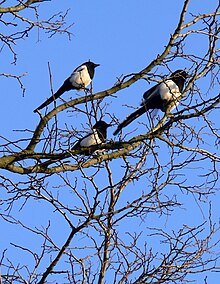One for Sorrow (nursery rhyme)
| "One for Sorrow" | |
|---|---|
 Three magpies in a tree | |
| Nursery rhyme | |
| Published | c. 1780 |
"One for Sorrow" is a traditional children's nursery rhyme about magpies. According to an old superstition, the number of magpies seen tells if one will have bad or good luck.
Lyrics[]
There is considerable variation in the lyrics used. A common modern version is:
Origins[]

The rhyme has its origins in superstitions connected with magpies, considered a bird of ill omen in some cultures, and in Britain, at least as far back as the early sixteenth century.[4] The rhyme was first recorded around 1780 in a note in John Brand's Observations on Popular Antiquities on Lincolnshire with the lyric:
One for sorrow,
Two for mirth,
Three for a funeral
And four for birth
One of the earliest versions to extend this was published, with variations, in Michael Aislabie Denham's Proverbs and Popular Saying of the Seasons (London, 1846)
One for sorrow,
Two for mirth
Three for a funeral,
Four for birth
Five for heaven
Six for hell
Seven for the devil, his own self
On occasion, jackdaws, crows and other Corvidae are associated with the rhyme, particularly in America where magpies are less common.[5]
A version of the rhyme became familiar to many UK children when it became the theme tune of the children's TV show Magpie, which ran from 1968 to 1980.[6] The popularity of this version is thought to have displaced the many regional versions that had previously existed.[7]
Notes[]
- ^ "One for Sorrow | Magpie Nursery Rhyme".
- ^ P. Tate (2010). Flights of Fancy: Birds in Myth, Legend, and Superstition. New York: Random House. ISBN 978-1409035695.
- ^ Finaldi, Gabriele (1 December 1992). "Picture Choice: Gabriele Finaldi on pictorial wisdom in Piero's relaxed Nativity". The Independent. Retrieved 2 February 2013.
- ^ I. Opie and M. Tatem, eds, A Dictionary of Superstitions (Oxford University Press, 1989), pp. 235-6.
- ^ J. M. Marzluff, A. Angell, P. R. Ehrlich, In the Company of Crows and Ravens (Yale University Press, 2007), p. 127.
- ^ Wilkinson, Dean (18 July 2011). The Classic Children's Television Quiz Book. Andrews UK Limited. ISBN 978-1-908548-89-4. Retrieved 15 February 2021.
- ^ Terry Pratchett and Jacqueline Simpson, The Folklore of Discworld (London: Random House, 2010), ISBN 1407034243, p. 449.
References[]
- Binney, Ruth (2004). Wise Words and Country Ways: Traditional Advice and Whether It Works Today. David & Charles. p. 223. ISBN 0-7153-1846-2.
- The Crow: City of Angels. 1996.
- English nursery rhymes
- English folk songs
- English children's songs
- Traditional children's songs
- Songs about birds
- Songs about luck
- Birds in mythology